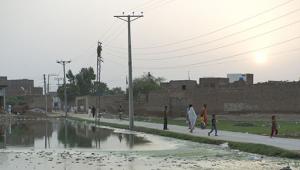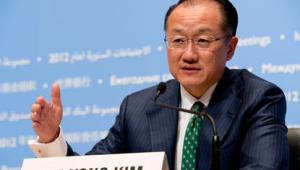Dr Jim Yong Kim is no stranger to development. The 12th President of The World Bank Group (WBG) may have left a role in academia to join the WBG in June last year, but there’s been little need for him to learn on the job.
Not only is he a former director of the HIV/AIDS Department at the World Health Organization, but, fired by his conviction that everyone is entitled to first-class health care, no matter where they live or how poor they are, he is also co-founder of Partners in Health, a pioneering organization dedicated to treating poor people in Haiti, Peru, Rwanda and other developing countries. It’s quite a résumé, and one that fully answers President Obama’s wish for “a development professional to lead the world’s largest development agency.” So, a little over a year since taking the reins, how is he getting on?
Delegates, guests and representatives of the WBG’s 188 member countries who gathered for its recent annual meetings in Washington DC were left in little doubt of his current priorities: ending extreme poverty by 2030, boosting shared prosperity for the bottom 40% of the population in developing countries and implementing a set of sweeping internal reforms that aim to make the organization more efficient and better able to achieve its ambitious goals.
Direction of travel
Established in 1944, WBG is not a bank in the classic sense, but rather a source of financial and technical assistance to developing countries around the world. It provides low-interest loans, interest-free credits and grants to developing countries, supporting investments in sectors ranging from education to environment and health to agriculture. The WBG also offers support to developing countries through policy advice, research and analysis, and technical assistance.
As President, Dr. Kim chairs meetings of the Boards of Directors and is responsible for overall management, but he is keen to stress that the strategy to end poverty is rooted in the words and deeds of staff from across the organization. “When I first walked in the Bank’s headquarters and visited country office units, I asked them what it is that makes them most proud of working for the Bank and to a person they said ‘we’re here to fight poverty,’” he recalls.
“This idea grew and grew, and now we have a target to end poverty by 2030. This means bringing it down to a level as low as we can possibly go — and that’s 3% of the global population. With so much conflict in the world, 3% is about as good as we can do. So the strategy is focused on getting us to the target. The second focus for us is what we call ‘shared prosperity.’ This means we’re focusing specifically on the income of the bottom 40%.”
Speaking during the annual meetings, Dr. Kim was keen to stress that this is the first time in the history of the Bank that it is pursuing two overarching goals that have been voted on by its member countries. But that doesn’t mean they are easily achievable — anything but. “Right now, we’re at about 18%,” he concedes. “We don’t think there’s any way we can get to 3% unless we’re at 9% by 2020. So this means we’re aiming to halve poverty in seven years. This is a lot of work for us to do and our public sector and private sector teams have to work together to accomplish this goal. It’s no one size fits all — every country is different.”
Repositioning the Bank
The WBG consists of five separate groups. The International Bank for Reconstruction and Development lends to governments of middle-income and creditworthy low-income countries. The International Development Association provides interest-free loans and grants to governments of the poorest countries. The International Finance Corporation helps developing countries achieve sustainable growth by financing investment, mobilizing capital in international financial markets, and providing advisory services to businesses and governments. The Multilateral Investment Guarantee Agency promotes foreign direct investment into developing countries by offering guarantees to investors and lenders. And the International Centre for Settlement of Investment Disputes provides international facilities for conciliation and arbitration of investment disputes.
All of these organizations will be affected by Dr. Kim’s reform program. “What we’re doing is really taking apart the Bank and putting it back together so that it works in a way that enables us to help us reach that 3% target and really boost the incomes of the bottom 40%,” he says. “We did a survey of the whole organization and the results were not pretty. We asked if the structure was set up in a way that allowed them to do their best work, and the answer was ‘no.’
“We also asked technical people in one region how much of their time they spend providing support to people in other regions, and the answer was less than 1%,” he adds. “So there was no cross-fertilization of knowledge between the regions. This means that, if there was a great innovation in one region, it was effectively going to stay in that region. They said we were less than the sum of our parts — this was the message loud and clear coming from the staff.”
Under the proposals, the WBG will find at least a US$400m reduction in annual administrative costs over the next three years. In doing so, the organization will change the way it designs its budget and better align budgets with strategy. There are also plans to explore new ways to grow revenue to better serve its clients.
“We’re going to ask ourselves every day whether or not we’re making progress against our goals,” says Dr. Kim. “Because what happens in bureaucracies is that the incentives sometimes get a little bit misaligned with the mission. In other words, if the incentive is to get your loan or deal through the board as quickly as possible, we end up with a hodge-podge of different projects that were good for the career advancement of the individual, but maybe not aligned with the strategy of a country to actually end extreme poverty. This doesn’t mean we’re going to withdraw from any sector. We did that years ago with infrastructure and agriculture, and it was a mistake because it’s not about the sector — it’s about how we do our work.”
Dr. Kim goes on to say that he is fully expecting to meet some resistance. “I’ve done this twice before,” he points out. “The key is for our senior leadership to not back off when meeting resistance or meeting noise. There will be resistance, there will be noise. But at the end of the day, I am convinced that we can do this and the organization will work much more effectively afterward. It’s a matter of not losing nerve.”
Making a difference
The reform program is clearly important and something that Dr. Kim passionately believes in. But perhaps it is not as magical as the opportunity to make a positive difference in people’s lives — a mission that underpins the work of both himself and his teams at the Bank.
“I’ve been doing development my whole life,” he reflects. “At the Bank, the time when people get most passionate is when they talk about lifting people out of poverty. The excitement that our people have in solving problems is an excitement that I share with them. We have this wonderful experience of going into a situation and actually making it better and seeing the difference in people’s lives.” It’s an experience that Dr. Kim fully intends to maximize in the months and years to come.
This feature was first published in the December issue of EY's Dynamics













